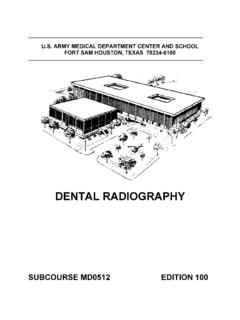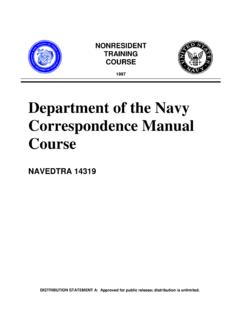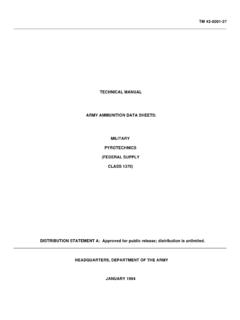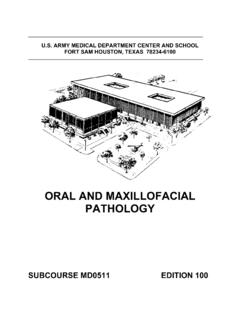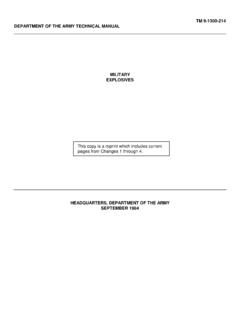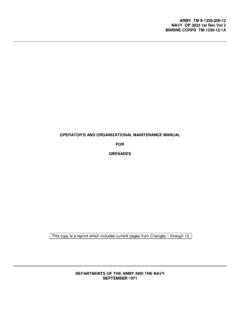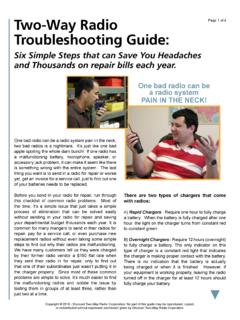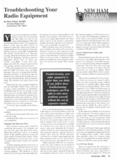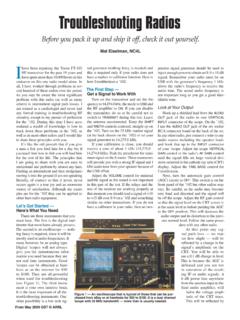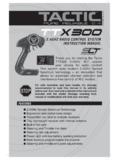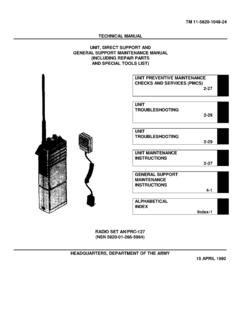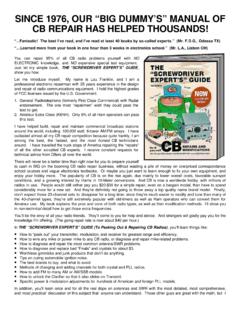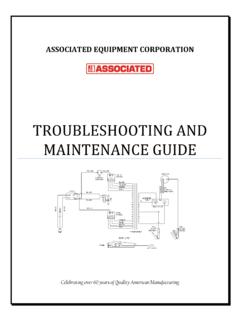Transcription of INTRODUCTION TO LOGICAL TROUBLESHOOTING
1 SUBCOURSEEDITIONIT0338 AUS ARMY INTELLIGENCE CENTERINTRODUCTION TO LOGICALTROUBLESHOOTINGINTRODUCTION TO LOGICAL TROUBLESHOOTINGS ubcourse Number IT0338 EDITION AUS ARMY INTELLIGENCE CENTERFORT HUACHUCA, AZ 85613 60002 Credit HoursEdition Date: May 1996 SUBCOURSE OVERVIEWThis subcourse is designed to teach you the concepts of troubleshootingelectronic subcourse replaces SA are no prerequisites for this LEARNING OBJEC TIV E: TASK:You will be able to do each of the following: Select the four requirements for good TROUBLESHOOTING . Determine the two major questions in TROUBLESHOOTING . Identify the steps necessary to establish initial bracketswhen TROUBLESHOOTING . Label examples of and define signal flowpaths. Select the correct order of checks which constitutes an"information funnel." Determine the best procedure for TROUBLESHOOTING multiplemalfunctions in an electronic :Given correct and incorrect statements and definitions inthis subcourseSTANDARD:To demonstrate competency of this task, you must achieve aminimum of 70 percent on the subcourse OF CONTENTSS ectionPageSubcourse OverviewiLesson1 1IT0338iiLESSONINTRODUCTION TO LOGICAL TROUBLESHOOTINGCRITICAL TASK: NONEOVERVIEWLESSON DESCRIPTION:Upon completion of this lesson you will understand and be able to identifythe concepts of TROUBLESHOOTING electronic LEARNING OBJECTIVE:TASK.
2 Select the four requirements for good TROUBLESHOOTING ,determine the two major questions in TROUBLESHOOTING ,identify the steps necessary to establish initial bracketswhen TROUBLESHOOTING , label examples of and define signalflowpaths, select the correct order of checks whichconstitutes an "information funnel," and determine the bestprocedure for TROUBLESHOOTING multiple malfunctions in anelectronic :Given the information provided in this :To demonstrate competency of this task, you must achieve aminimum of 70 percent on the subcourse are four requirements for good TROUBLESHOOTING . A technician musthave a knowledge of the system operation, , a communications system, afire control system, or a complete weapons system. He must also have aknowledge of the use of test equipment . Without the effective use of testequipment, a technician will waste valuable time.
3 The effective use oftechnical manuals and other references is also an important requirement forgood TROUBLESHOOTING . Every system used today has many manuals whichexplain the operation of the system. These are invaluable aids to thetechnician. The most important requirement for good TROUBLESHOOTING ,however, is the LOGICAL analysis of inf or mati on obtai ne d from themalfunctioning system. The symptoms are available, but it is up to thetechnician to obtain them quickly, to interpret them rapidly and correctlyso that he can repair the system technicians attempt to troubleshoot malfunctioning systems, but theyare unsuccessful or only partially successful. There are not magicalmethods available for becoming a good troubleshooter; however, there aregood and bad, difficult and easy methods. There are four requirements,however, which every technician must be aware of if he is to become a goodtroubleshooter and utilize the good and easy methods.
4 List the four requirements for good TROUBLESHOOTING in the space providedbelow:(1) (2) (3) (4) IT03381 2 Answers for frame 2:(1)detailed knowledge of system operation.(2)knowledge of use of test equipment .(3)effective use of technical manuals.(4) LOGICAL analysis of information gained from malfunctioning technician should constantly strive to improve his knowledge of thesystems he works with, his use of test equipment , and his effective use oftechnical manuals. However, the LOGICAL analysis of information gained froma malfunctioning system requires first that he consider two importantquestions:(1)Where to troubleshoot?
5 (2)What to troubleshoot?Most modern electronic systems consist of many circuits and components. Toapproach a malfunctioning system blindly, hoping to stumble on the trouble,only wastes time and creates problems. Normally, only one portion of asystem goes bad at once. By isolating the bad portion, the work of thetechnician can be made much easier. He must know where to are three steps which can help him isolate the bad portion of a systemfrom the rest of it. First, all the symptoms must be found. Next, theabnormal signal paths (circuits or components showing faultycharacteristics) must be determined. Last of all, the troubleshooter mustestablish brackets, either mentally or on a block diagram of the system, toisolate the malfunctioning portion of the system from the normal three steps are used to establish "initial brackets.
6 " Initialbrackets help the troubleshooter avoid making pointless checks later get him started on the right 3IT03383.(Continued)State the two major questions in TROUBLESHOOTING .(1) (2) Three steps are necessary to establish initial brackets whentroubleshooting. Arrange the steps listed below in their correct order byplacing the correct number 1,2,3) in the parentheses.( )Locate the abnormal signal paths (circuits).( )Find all the symptoms.( )Establish the 4 Answers for frame 3:(1)Where to troubleshoot?(2)What to troubleshoot?Correct order is 2, 1, is meant by establishing brackets? Let's take a typical problem andestablish initial brackets. Figure 1 1 shows a block diagram of acombination AM/FM radio and a phonograph. The AM and the phonograph workperfectly, but when the FM is selected, only a quiet hum is heard from thespeaker.
7 The first bracket would be placed on the block diagram at thepoint where the first indication of an abnormal signal path exists. Thesecond bracket would be placed where the normal signal path exists sothat ALL the affected circuits (or components) are included within 1 , to establish initial brackets: find all the symptoms, locatethe abnormal signal paths, and then establish the brackets. On Figure 1 1,establish the brackets for the trouble described 6 Answer for frame 4:The first bracket should have been placed at the left ofthe FM antenna. The second bracket should have beenplaced to the right of the selector switch so that theantenna, the FM block, and the FM switch were includedbetween the initial the list below, select four requirements for good TROUBLESHOOTING .(Circle your choices.) of the use of test of the system operators use of technical use of spare analysis of information obtained from malfunctioning knowledge of all previous knowledge of system operationAnswers for frame 5: a, c, e, g1 brackets helps the technician avoid pointless checks.
8 Thereare three types of pointless checks which should be avoided: irrelevantchecks, redundant checks, and premature checks. An irrelevant check is acheck outside the brackets; it is unimportant and has no relation to thesuspected trouble. A redundant check is a check which has been madealready; it is time consuming and gives no new information. A prematurecheck is a check which does not reveal anything because enough otherinformation is not known; it would have been done check which has already been made is called a check outside the brackets is called an check made too soon which should have been made later is a for frame 6: redundant, irrelevant, prematureIT03381 time to establish initial brackets is important because it ensuresgetting started on the right track. The first step in establishing initialbrackets is to find all the symptoms.
9 Most of these can be observed bychecking the "front panel" the operating controls for the complete it is a simple communications receiver or a complicated bomb directorsystem, by checking for the proper functions of each operation control thetroubleshooter can narrow down the possibilities and choices he must he has found all the symptoms, he can go to a schematic or a blockdiagram and note the affected signal paths or circuits. He must be sure toinclude every stage and component which is in some way affected by thetrouble. Once he has done this, he is ready to establish his initialbrackets. They may include the whole system, or they may include only asmall portion of the system. When these have been established, the troublearea has been determined. The troubleshooter can avoid making pointlesschecks by checking within the brackets, by avoiding redundant checks andpremature checks.
10 Each check made should shift one or the other bracketcloser to the trouble until only the exact trouble the following terms with their definitions by placing the correctletter in each the the the affectedstages or and what tocheck?___First step to establish initial brackets___Check outside the brackets___Check not usable for lack of information___Last step to establish initial brackets___Check which is repeated not necessary___Second step is to establish initial brackets___Two major questions in TROUBLESHOOTING \1 9IT0338 Answers for frame 7: (From top to bottom) d, e, a, c, b, f, following questions will check your understanding of some of theInformation presented this far. Answer them to the best of your ability andcheck your answers at the top of page 1 the two major questions in steps are necessary to establish initial brackets whentroubleshooting.
